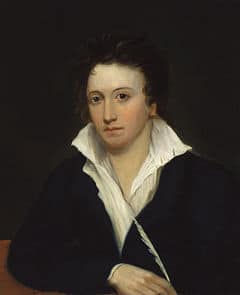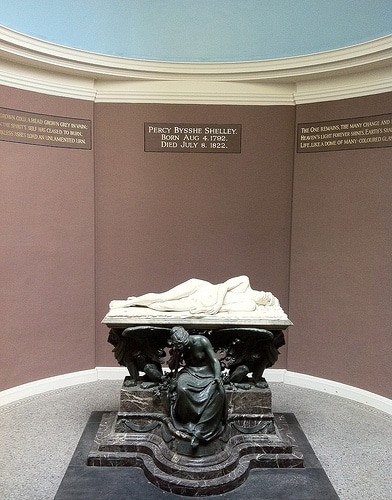Percy Bysshe Shelley Biography
Percy Bysshe Shelley (1792-1822) – English Romantic poet
Shelley was an influential English romantic poet, famous for his lyrical poetry and idealistic radical political thought. He was also generous in his support and encouragement of fellow poets, and was a key figure in the development of English romantic poetry.
“Till the Future dares
Forget the Past, his fate and fame shall be
An echo and a light unto eternity!”
Percy Bysshe Shelley – Adonais (1821)
Short Bio of Shelley
Shelley was born into a minor aristocratic family. His father, Sir Timothy Shelley,  was a Whig Member of Parliament. For schooling, Shelley was sent to Syon House and later Eton College. At an early age, Shelley developed unorthodox views and attitudes, which often caused him to be bullied by classmates. His unhappy life in school institutions caused him to withdraw into reading and made him even more independently minded.
was a Whig Member of Parliament. For schooling, Shelley was sent to Syon House and later Eton College. At an early age, Shelley developed unorthodox views and attitudes, which often caused him to be bullied by classmates. His unhappy life in school institutions caused him to withdraw into reading and made him even more independently minded.
 was a Whig Member of Parliament. For schooling, Shelley was sent to Syon House and later Eton College. At an early age, Shelley developed unorthodox views and attitudes, which often caused him to be bullied by classmates. His unhappy life in school institutions caused him to withdraw into reading and made him even more independently minded.
was a Whig Member of Parliament. For schooling, Shelley was sent to Syon House and later Eton College. At an early age, Shelley developed unorthodox views and attitudes, which often caused him to be bullied by classmates. His unhappy life in school institutions caused him to withdraw into reading and made him even more independently minded.Shelley at Oxford and Views on Religion
In 1810, Shelley went to University College, Oxford. It was widely held that he rarely attended formal lectures; instead preferring to read his own selection of books. It was at Oxford that he published his first poetry and novel Zastrozzi (1810). In the following year he wrote another novel and a pamphlet ‘The Necessity of Atheism‘. In this pamphlet Shelley questioned the existence of God, and the role of Christianity.
“If he is infinitely good, what reason should we have to fear him?”“If he is infinitely wise, why should we have doubts concerning our future?”
Percy Bysshe Shelley – The Necessity of Atheism (1811)
Shelley also questioned the supremacy of the Church of England as the religion of the UK. At the time, this criticism of Church and God was considered unacceptable.
After refusing to repudiate the pamphlet Shelly was expelled from Oxford in March 2011.
“Here I swear, and as I break my oath may Infinity Eternity blast me, here I swear that never will I forgive Christianity!”
Letter to Thomas Jefferson Hogg (1811-01-03)
Yet, like William Blake, Shelley held the inspiration of Christianity, Jesus Christ, in great veneration. He contended that the teachings and life of Jesus had been misrepresented by the Christian Church.
“Jesus Christ represented God as the principle of all good, the source of all happiness, the wise and benevolent Creator and Preserver of all living things. But the interpreters of his doctrines have confounded the good and the evil principle.”
Percy Bysshe Shelley – Essay on Christianity (1859) (note published after his death)
First Marriage
Four months later, Shelley eloped to Scotland with a 16 year old schoolgirl – Harriet Westbrook, where they got married. Combined with his expulsion from Oxford, this led to a deep estrangement from his father and family. However, the youthful marriage was not successful and despite having a child (Lanthe Shelley) they later separated.
During this time, Shelley often visited Ireland where he become noted as a radical and supporter of Irish nationalism; this brought him to the attention of the British authorities.
Marriage to Mary Godwin
In 1814, he travelled to London, where he became acquainted with utilitarian philosopher William Godwin. Here he met Mary Godwin (daughter of William Godwin and Mary Wollstonecraft). Shelley fell in love and left his wife to take Mary on a tour of Europe. After several months, they had to return to England after running low on funds.
Shelley was strongly influenced by the poetry of William Wordsworth, who was one of first Romantic poets to gain national recognition. He also became close to the two great romantic poets – John Keats and Lord Byron. Shelley was a great supporter of Keats, even when his Endymion had been heavily criticised by the press. After the death of Keats, Shelley wrote the elegy Adonais, one of his greatest works.
“The One remains, the many change and pass;
Heaven’s light forever shines, Earth’s shadows fly;
Life, like a dome of many-coloured glass,
Stains the white radiance of Eternity,
Until Death tramples it to fragments.”
Percy Bysshe Shelley – Adonais (1821)
Shelley also spent much time with Lord Byron in both Switzerland and later Italy. From this literary friendship, Shelley gained more inspiration for his poetry.
In 1818, Shelley was in Rome, when wrote his classic Prometheus Unbound – a reworking of a Greek classic. However, on a personal level, he suffered many tragic events. His first wife committed suicide in 1816, and in 1818 and 1819, his young son and daughter both died in infancy.
As well as beautiful lyrical poetry, Shelley also increasingly ventured into political criticism. Shelley was highly critical of the perceived cruelty and injustice of the British establishment, highlighted in incidents such as the Peterloo massacre. His essays such as, Philosophical View of Reform; and poems such as, Queen Mab, and the Men of England, inspired later radicals and socialists, from Karl Marx to George Bernard Shaw.
Shelley’s espousal of non-violent resistance to injustice also inspired later activists such as Henry David Thoreau and Mahatma Gandhi. Shelley was a principled supporter of rights for all in society, and not just the few.
“GOVERNMENT has no rights; it is a delegation from several individuals for the purpose of securing their own. It is therefore just, only so far as it exists by their consent, useful only so far as it operates to their well-being.”
“Declaration of Rights” (1812), article 1
Shelly was also an early advocate of vegetarianism as a way to extend sympathy to all life forms.
In 1822, with Byron and Leigh Hunt, Shelly started a left wing journal called The Liberal. However, shortly after setting up the journal, Shelley’s life was tragically cut short, when he was caught up in a sudden storm on the Italian coast.
His body was later washed up on shore near Viareggio. A statue of Shelley’s washed up body was commissioned by his daughter in law and the statue by Edward Onslow Ford stands as a memorial to Shelley at University College, Oxford University.
Shelley Statue – University College, Oxford
In 1820, Shelley wrote a poem on the concept of his own cenotaph
I silently laugh at my own cenotaph,
And out of the caverns of rain,
Like a child from the womb, like a ghost from the tomb,
I arise and unbuild it again.
The Cloud (1820)
Despite being a scourge of the British political establishment during his life, he eventually was given a memorial in Poet’s Corner at Westminster Abbey.




No comments:
Post a Comment